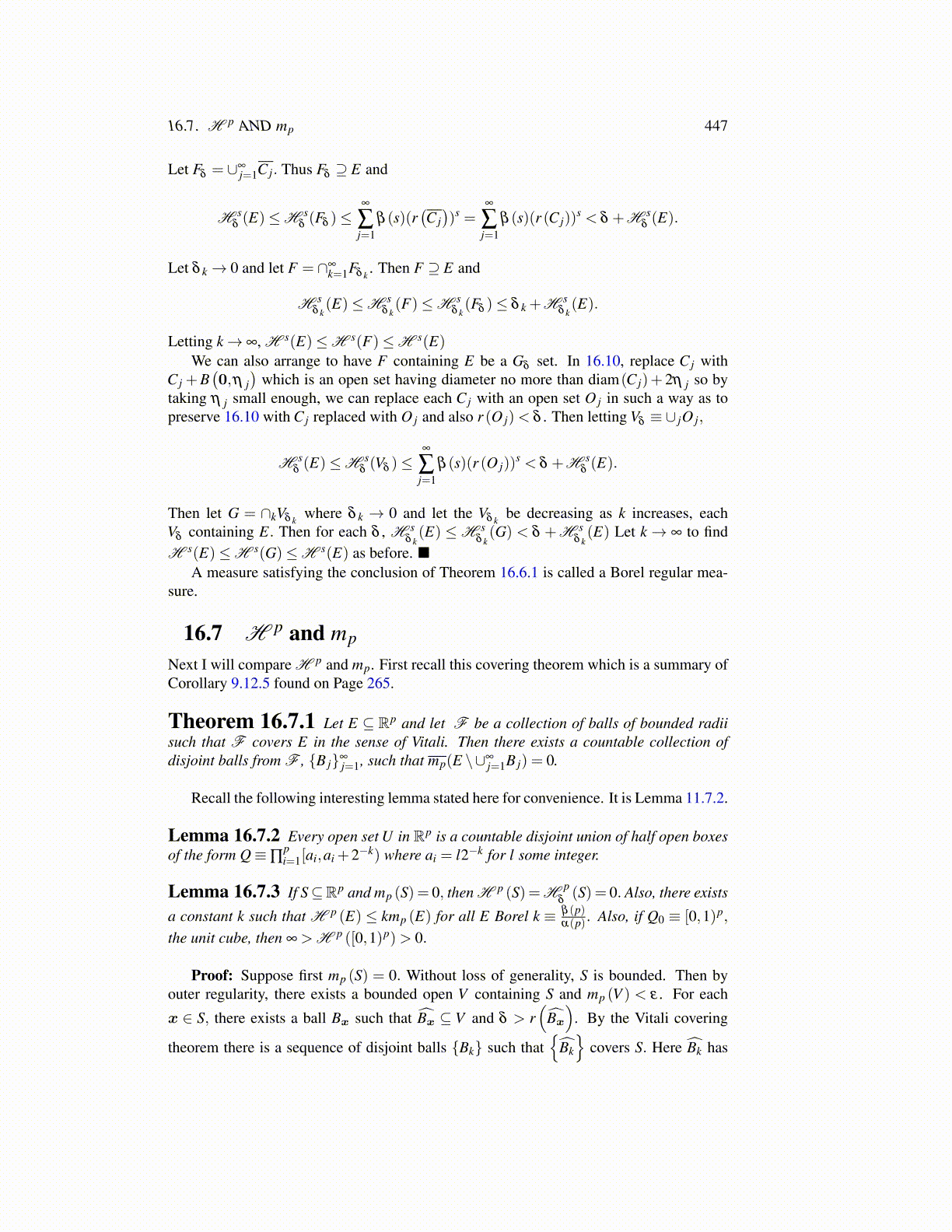
16.7. H p AND mp 447
Let Fδ = ∪∞j=1C j. Thus Fδ ⊇ E and
H sδ(E)≤H s
δ(Fδ )≤
∞
∑j=1
β (s)(r(C j))s =
∞
∑j=1
β (s)(r (C j))s < δ +H s
δ(E).
Let δ k→ 0 and let F = ∩∞k=1Fδ k
. Then F ⊇ E and
H sδ k(E)≤H s
δ k(F)≤H s
δ k(Fδ )≤ δ k +H s
δ k(E).
Letting k→ ∞, H s(E)≤H s(F)≤H s(E)We can also arrange to have F containing E be a Gδ set. In 16.10, replace C j with
C j +B(0,η j
)which is an open set having diameter no more than diam(C j)+ 2η j so by
taking η j small enough, we can replace each C j with an open set O j in such a way as topreserve 16.10 with C j replaced with O j and also r (O j)< δ . Then letting Vδ ≡ ∪ jO j,
H sδ(E)≤H s
δ(Vδ )≤
∞
∑j=1
β (s)(r (O j))s < δ +H s
δ(E).
Then let G = ∩kVδ kwhere δ k → 0 and let the Vδ k
be decreasing as k increases, eachVδ containing E. Then for each δ , H s
δ k(E) ≤H s
δ k(G) < δ +H s
δ k(E) Let k→ ∞ to find
H s(E)≤H s(G)≤H s(E) as before. ■A measure satisfying the conclusion of Theorem 16.6.1 is called a Borel regular mea-
sure.
16.7 H p and mp
Next I will compare H p and mp. First recall this covering theorem which is a summary ofCorollary 9.12.5 found on Page 265.
Theorem 16.7.1 Let E ⊆ Rp and let F be a collection of balls of bounded radiisuch that F covers E in the sense of Vitali. Then there exists a countable collection ofdisjoint balls from F , {B j}∞
j=1, such that mp(E \∪∞j=1B j) = 0.
Recall the following interesting lemma stated here for convenience. It is Lemma 11.7.2.
Lemma 16.7.2 Every open set U in Rp is a countable disjoint union of half open boxesof the form Q≡∏
pi=1[ai,ai +2−k) where ai = l2−k for l some integer.
Lemma 16.7.3 If S⊆Rp and mp (S) = 0, then H p (S) =H pδ(S) = 0. Also, there exists
a constant k such that H p (E) ≤ kmp (E) for all E Borel k ≡ β (p)α(p) . Also, if Q0 ≡ [0,1)p,
the unit cube, then ∞ > H p ([0,1)p)> 0.
Proof: Suppose first mp (S) = 0. Without loss of generality, S is bounded. Then byouter regularity, there exists a bounded open V containing S and mp (V ) < ε . For each
x ∈ S, there exists a ball Bx such that B̂x ⊆ V and δ > r(
B̂x
). By the Vitali covering
theorem there is a sequence of disjoint balls {Bk} such that{
B̂k
}covers S. Here B̂k has